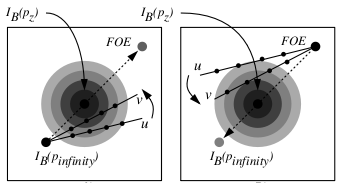Résumé

We propose a new paradigm, motion without structure, for determining the ego-motion between two frames. It is best suited for cases where reliable feature point correspondence is difficult, or for cases where the expected camera motion is large. The problem is posed as a five-dimensional search over the space of possible motions during which the structural information present in the two views is neither implicitly or explicitly used or estimated. To accomplish this search, a cost function is devised that measures the relative likelihood of each hypothesized motion. This cost function is invariant to the structure present in the scene. An analysis of the global scene statistics present in an image, together with the geometry of epipolar misalignment, suggests a measure based on the sum of squared differences between pixels in the first image and their corresponding epipolar line segments in the second image. The measure relies on a simple statistical characteristic of neighboring image intensity levels. Specifically, that the variance of intensity differences between two arbitrary points in an image is a monotonically increasing symmetrical function of the distance between the two points. This assumption is almost always true, though the size of the neighborhood over which the monotonic dependency holds varies from image to image. This range determines the maximum permissible motion between two frames, which can be quite large. Experiments with both outdoor scenes and an indoor calibrated sequence achieve very good accuracy (less then I pixel image displacement error) and robustness to noise.
Documents
